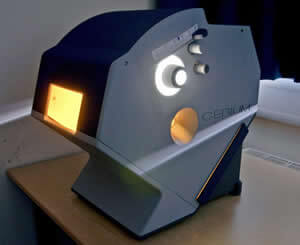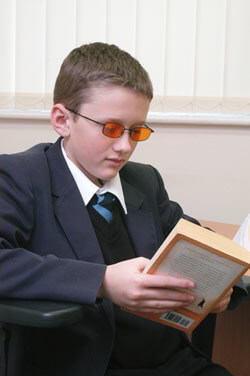INTUITIVE COLORIMETER
This Intuitive Colorimeter was developed by Professor Arnold Wilkins and the Medical Research Council. It is fully supported by research studies and peer reviewed controlled trials.

This optometric instrument is used by our Behavioural Optometrists to logically and sequentially explore colour space in order to find the optimal precision tint for the relief of perceptual distortions in visual stress.
The Intuitive Colorimeter independently changes the three parameters of colour – hue, saturation and brightness – while the eyes are colour adapted. This will allow for the selection of one colour, which is tailored to cater to each individual’s needs. The colour will be different for each patient and the precision coming from a choice of over 100,000 colour combinations is now available.
WHAT IS VISUAL STRESS?

Visual Stress refers to reading difficulties, light sensitivity and headaches from exposure to disturbing visual patterns. The symptoms can occur despite normal eyesight and can affect reading fluency, concentration and comprehension, as well as causing rapid fatigue. Research indicates that around 5% of the population is severely affected by visual stress and up to 20% to a lesser degree.
Visual perceptual distortion should be suspected in children who have difficulties learning to read, particularly if they report headaches and eyestrain from prolonged exposure to the page. If the child reports any illusory movement of the letters or words, or glare from the white paper, then treatment with coloured overlays or filters should be considered.
Children with reading problems are more likely than others to report visual perceptual distortion, and to benefit from coloured overlays or coloured lenses. A smaller proportion of good readers also show similar benefits. Individuals with dyslexia, dyspraxia, photosensitive epilepsy, autism and ADHD are more prone to develop visual stress.
Symptoms of Visual Stress may include:
- Movement or blurring of print
- Letters fading, becoming darker or changing shape or size
- Illusions of colour (blobs of colour on the page or colours surrounding letters or words)
- Rapid tiring
- Headache or eyestrain
Signs of Visual Stress may include:
- Moving closer to or away from the page
- Becoming restless
- Using finger as a marker
- Skipping words and lines
- Rubbing eyes and blinking excessively
- Low self-esteem
